Seton Hill Then & Now

Swinging The Gates Of An Era
1882
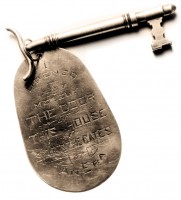 On August 7, 1882, Mother Superior Aloysia Lowe of the Sisters of Charity purchased 200 rolling acres of farmland in Greensburg, Pa., to be the site of a Mother House for the Sisters in the region. Known locally as the Jennings farm, Mother Aloysia rechristened the estate “Seton Hill,” in honor of Elizabeth Ann Seton, the founder of the Sisters of Charity, and because the hill upon which the property sat reminded her of one of the hills of Rome, the center of Christianity. The property had fallen into neglect over the years but a few usable buildings remained, including the Stokes mansion. Named for previous owner William A. Stokes, a wealthy lawyer and a major in the Civil War, this grand home had once contained the first private library Andrew Carnegie had ever seen, inspiring the public libraries he established in later years. The Rev. Daniel Richard Sullivan, a future president of Seton Hill College commemorated the arrival of the Sisters to
Seton Hill by later engraving upon the key to this mansion: “I opened not merely the door of this house. I swung the gates of an era.”
On August 7, 1882, Mother Superior Aloysia Lowe of the Sisters of Charity purchased 200 rolling acres of farmland in Greensburg, Pa., to be the site of a Mother House for the Sisters in the region. Known locally as the Jennings farm, Mother Aloysia rechristened the estate “Seton Hill,” in honor of Elizabeth Ann Seton, the founder of the Sisters of Charity, and because the hill upon which the property sat reminded her of one of the hills of Rome, the center of Christianity. The property had fallen into neglect over the years but a few usable buildings remained, including the Stokes mansion. Named for previous owner William A. Stokes, a wealthy lawyer and a major in the Civil War, this grand home had once contained the first private library Andrew Carnegie had ever seen, inspiring the public libraries he established in later years. The Rev. Daniel Richard Sullivan, a future president of Seton Hill College commemorated the arrival of the Sisters to
Seton Hill by later engraving upon the key to this mansion: “I opened not merely the door of this house. I swung the gates of an era.”
1883
Since the purchase of Seton Hill had emptied the small black handbag the Sisters used for a treasury, the work of renovating the Stokes mansion and bringing the farm back to life fell to the Sisters. Pioneers in every way, they slept on cots in the old Stokes mansion and used boxes for furniture while spending the days scrubbing, whitewashing, and making repairs. For water, they had several springs on the property; for food, they had their small farm, they also gardened and harvested fruit from the orchard. When the Sisters decided that a better road to the mansion was needed, they dedicated their evening “recreation” hour to the building of one, using stones they found on the property. The Sisters not only worked hard, they didn’t waste time. In September 1883, only one year after the purchase of the property, the Sisters opened Saint Joseph Academy, a boarding school for girls. Sister Adelaide Dunn was its first directress. Seven young women attended the Academy in its inaugural year; the very first student to enroll was Antoinette McLaughlin.
1885
The Sisters of Charity of Seton Hill charter of incorporation received official approval on February 7, 1885.
1886
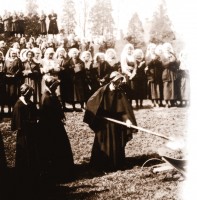 At the end of its second year of existence, Saint Joseph Academy had already outgrown the space available to it in the old mansion. On September 7, 1886, Sr. Mary Josephine (later a Mother Superior), removed the first shovelful of earth on the site of a new building that would serve both as Mother House for the Sisters and living space and school for the girls of Saint Joseph Academy. In 1886, this six floor, 81,000 + square foot building - to be constructed at the top of a steep hill without the aid of modern machinery – was a tremendous undertaking.
At the end of its second year of existence, Saint Joseph Academy had already outgrown the space available to it in the old mansion. On September 7, 1886, Sr. Mary Josephine (later a Mother Superior), removed the first shovelful of earth on the site of a new building that would serve both as Mother House for the Sisters and living space and school for the girls of Saint Joseph Academy. In 1886, this six floor, 81,000 + square foot building - to be constructed at the top of a steep hill without the aid of modern machinery – was a tremendous undertaking.
1887
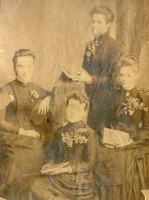 At an elaborate ceremony attended by 1,500 guests on April 21, 1887, the cornerstone for the new building was laid in place. The students and Sisters present at the event each signed their name to a scroll of paper that was placed - along with a medal, rosary, or relic from each - into the cornerstone of the building.Also placed into the cornerstone were copies of the newspapers of the day, a number of rare coins, and pictures of Bishops Phelan and Tuigg. 1887 also marks the year that the Sisters’ Mother House and novitiate were permanently and officially established at Seton Hill, and the first year a class graduated from Saint Joseph Academy. The Saint Joseph Academy class of 1887 consisted of Sarah Sullivan, Rose Padden, Anastasia Casey and Alice Akers.
At an elaborate ceremony attended by 1,500 guests on April 21, 1887, the cornerstone for the new building was laid in place. The students and Sisters present at the event each signed their name to a scroll of paper that was placed - along with a medal, rosary, or relic from each - into the cornerstone of the building.Also placed into the cornerstone were copies of the newspapers of the day, a number of rare coins, and pictures of Bishops Phelan and Tuigg. 1887 also marks the year that the Sisters’ Mother House and novitiate were permanently and officially established at Seton Hill, and the first year a class graduated from Saint Joseph Academy. The Saint Joseph Academy class of 1887 consisted of Sarah Sullivan, Rose Padden, Anastasia Casey and Alice Akers.
The Finest Educational Institution In Western Pennsylvania
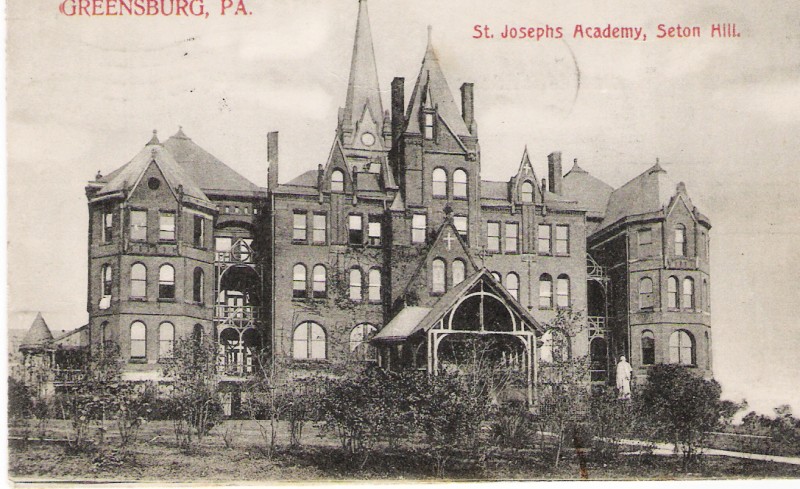
1889
The new building, designed in a Romanesque style by prominent Pittsburgh architect Joseph Stillburg and constructed of “Pittsburgh brick and Ohio sandstone,” was completed in the spring of 1889. Mother Aloysia had supervised every step, insisting at every turn on the best materials and workmanship – to the point that she and the Sisters became known for sitting or standing on any inferior materials delivered to the site to keep them from being used by the builders. The Altoona Times, on December 4, 1888, describes the building, then approaching completion, as “... the finest educational institution in Western Pennsylvania, a magnificent monument to the enterprise, industry, and perseverance of the Sisters ...” (Seton Hill University’s Administration Building still crowns “the Hill,” serving hundreds of students, faculty, staff an visitors daily. ) Also in 1889, Saint Mary’s Preparatory School for Boys, begun in Saint Mary’s Convent in Blairsville, Pa., was moved to Seton Hill. Saint Mary’s School was housed in the former Mother House (the Stokes mansion), which has been referred to as Saint Mary Hall ever since. On Christmas Day, 1889, Mother Aloysia died, and was buried at Seton Hill, which she had recently described in a letter as “to me, the dearest spot on earth.”
1896
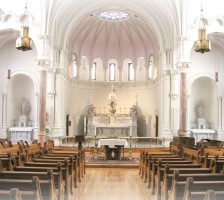 Saint Joseph Chapel, “the heart of Seton Hill,” was dedicated on November 18, 1896. Prior to this time a variety of temporary chapels had existed at Seton Hill; now, the Sisters had a permanent chapel of their own that would – at least for a little while – accommodate the Sisters, the young women of Saint Joseph Academy, and the boys of Saint Mary’s. Saint Joseph Chapel, with its pillars of rose Georgian marble, intricately sculpted high and side altars of Carerra marble, 18 stained glass windows (including two 16 foot rose windows and a circular angel window in the ceiling above the altar) and hand carved wooden pews, is still used daily at Seton Hill. Artist Mother Joseph Doran directed the construction of the chapel, and designed the stained-glass figures in its south front doors. Donations from the families and friends of the Sisters furnished the chapel; the Sisters and their families also donated gold jewelry to be melted down and reformed as a halo for the statue of the Virgin Mary. In stained glass above the main entrance are depicted values dear to the hearts of the Sisters of Charity: humility, simplicity and charity. The chapel’s pipe organ, donated by Andrew Carnegie a few years after the chapel’s completion, represents the first to be donated by him to a private institution. The wing that houses the chapel, constructed at the same time, is also home to Cecilian Hall. This majestic hall continues to serve Seton Hill as a venue for special events, performances, ceremonies and lectures.
Saint Joseph Chapel, “the heart of Seton Hill,” was dedicated on November 18, 1896. Prior to this time a variety of temporary chapels had existed at Seton Hill; now, the Sisters had a permanent chapel of their own that would – at least for a little while – accommodate the Sisters, the young women of Saint Joseph Academy, and the boys of Saint Mary’s. Saint Joseph Chapel, with its pillars of rose Georgian marble, intricately sculpted high and side altars of Carerra marble, 18 stained glass windows (including two 16 foot rose windows and a circular angel window in the ceiling above the altar) and hand carved wooden pews, is still used daily at Seton Hill. Artist Mother Joseph Doran directed the construction of the chapel, and designed the stained-glass figures in its south front doors. Donations from the families and friends of the Sisters furnished the chapel; the Sisters and their families also donated gold jewelry to be melted down and reformed as a halo for the statue of the Virgin Mary. In stained glass above the main entrance are depicted values dear to the hearts of the Sisters of Charity: humility, simplicity and charity. The chapel’s pipe organ, donated by Andrew Carnegie a few years after the chapel’s completion, represents the first to be donated by him to a private institution. The wing that houses the chapel, constructed at the same time, is also home to Cecilian Hall. This majestic hall continues to serve Seton Hill as a venue for special events, performances, ceremonies and lectures.
1899
200 Sisters of Charity, all pulling together, swung the new chapel bell into its tower on the eve of the Feast of the Assumption, 1899.
1908
Maura Hall, originally called Saint Mary’s Seminary, was completed in 1908 to serve as a new home for the boys of Saint Mary’s School. The new hall connected with the Mother House on three levels via an arcade-like passageway, and housed Saint Mary’s School until 1914. The third floor housed Saint Joseph Academy classrooms until the Academy’s closing in 1947.
1909
Seton Hill contained a working farm from the time the Sisters purchased the property until well into the 1960s. One evening in the fall of 1909, the original barn, which stood near the bend in the current entrance drive, burned to the ground. Workmen saved the few cows the Sisters owned, but all of the hay, grain and farm equipment stored in the barn were lost. The people of Greensburg came to the Sisters rescue, providing equipment and feed for the stock. This connection to, and support from, the local community exists into the present day, and is a partnership for which Seton Hill is enduringly grateful.
1911
The Pennsylvania Railroad built a new road in 1911 that connected Seton Hill’s hilltop buildings to College Avenue at the bottom of the hill. Prior to the construction of College Avenue and this drive, a long wooden boardwalk descended the hill and allowed pedestrians to cross the area at the bottom, known as “mudville,” in order to access the train station and downtown Greensburg. The main entrance to campus in Seton Hill’s earliest years, a road that crossed the railroad tracks near the Stokes mansion, no longer exists.
Fit for the World
1912
In the 1880s there were few careers other than teaching open to women. As a consequence, the traditional course of study for women laid great stress upon literature and history, modern languages and music. Mathematics received less emphasis; science had only a small part in any curriculum, even in universities. Needlework, drawing, watercolor painting, and training in speech and social behavior were the indispensable accomplishments of an educated young woman. The Sisters, always cognizant of Mother Seton’s wish to educate students “to fit you for that world in which you are destined to live” always required more of their charges. By 1912, the “Seton Hill Schools” – Saint Joseph Academy, Seton Hill Conservatory of Music, Seton Hill Conservatory of Art, and Saint Mary’s School for Boys – had reached a point of unsurpassed educational excellence. So it was that when Miss Juliet Power of Crafton, Pa., a high school graduate, applied for admission to Seton Hill in 1912 with the express purpose of taking courses in preparation for entering college, the Sisters felt they could accommodate her. At the end of one year, Miss Power applied to Trinity College in Washington, D.C., where she was accepted and given college credit for the courses she took at Saint Joseph Academy.
1913
In 1913, the Sisters began to pursue advanced degrees in order to be prepared to teach college level courses at Seton Hill. The Sisters continue to this day to earn degrees at the finest universities in the country, and to be represented among the faculty at Seton Hill.
1914
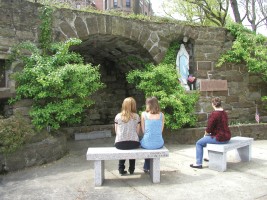 Seton Junior College, providing two years of college instruction for women, opened in 1914. Also in 1914 the Grotto of Our Lady of Lourdes was built in a wooded alcove to the right and below the Administration Building, where it remains to this day.
Seton Junior College, providing two years of college instruction for women, opened in 1914. Also in 1914 the Grotto of Our Lady of Lourdes was built in a wooded alcove to the right and below the Administration Building, where it remains to this day.
1916
Getting water to the top of a hill, and then to the top floor of a building on that hill, was a challenge for most of Seton Hill’s early history. As a result, for many years the Sisters did their summer washing at Lake Regina. The lake, named after Mother Regina Ennis, the Mistress of Novices in Seton Hill’s early years, was created using the waters of Sacred Heart Spring. Mother Josephine, a teacher of art, designed the lakebed in the form of a palette; turf was built up to form its walls. In the winter, the ice that formed on the lake was cut and saved in an icehouse. In April 1916, the Sisters sold the coal rights to 18 acres of their property and used the proceeds to fund the construction of new buildings. Many of the springs on the property were drained during the mining process, and Lake Regina faded to a faint outline. Fortunately, by that time a boiler house and a pumping system had been constructed on the property.
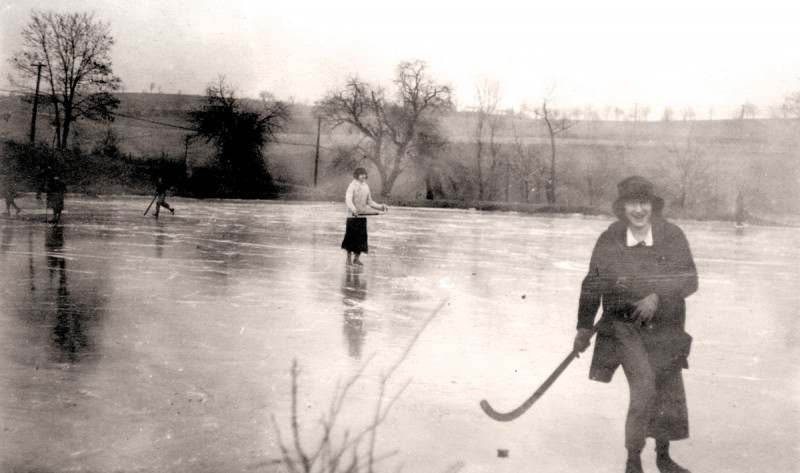
The Highest Standards of Achievement
1918
The Sisters began the application process for a college charter in 1916, but it wasn’t until April 12, 1918 – after years of legal and bureaucratic wrangling – that the Pennsylvania College and University Council approved the application for the charter, which was issued by the Court of Common Pleas of Westmoreland County on June 3, 1918. The original charter allowed the new Seton Hill College to confer Bachelor of Arts degrees in arts and music, and Bachelor of Science degrees in home economics. Mother Mary Joseph Havey was inaugurated as the first president of Seton Hill College. Sr. Electa Boyle later wrote in “Mother Seton’s Sisters of Charity in Western Pennsylvania” that “the group of Sisters who inaugurated the college work set for it the highest standards of achievement. No mediocrity found its way into the instruction of those first years...the passion for perfection which spurs on all true advance the founders of Seton Hill College possessed in abundance; and from this ideal the college has never retrograded.” Two lay faculty were hired in the college’s first year, Mary Josephine Wertheimer, associate professor of mathematics, and Michael J. Relihan, professor of classical languages.
1919
 Seton Hill’s first degrees, both Bachelors of Music, were conferred in June 1919 to Othelia Averman Vogel and Maria Caveney Coolahan, former students of Seton Hill’s Conservatory of Music. Sr. Francesca Brownlee, a previous directress of Saint Joseph Academy and the “guiding spirit” and tireless foot soldier in the effort to move Seton Hill from secondary school to college, was named dean of the college in 1919, a position in which she served until 1929. Sr. Francesca is widely believed to be the author of an article in the 1919 Seton Hill Bulletin that contains a directive which became one of the school’s guiding principles: “If the management of Seton Hill find a way of doing things that is better than their present method they will replace all of that method or any part of it without scruple, for they are bound by no traditions and they fear nothing but God’s disfavor and the closed mind.” The first issue of the student newspaper, the Setonian - “the student voice of the Hill” then and now - was produced in December 1919.
Seton Hill’s first degrees, both Bachelors of Music, were conferred in June 1919 to Othelia Averman Vogel and Maria Caveney Coolahan, former students of Seton Hill’s Conservatory of Music. Sr. Francesca Brownlee, a previous directress of Saint Joseph Academy and the “guiding spirit” and tireless foot soldier in the effort to move Seton Hill from secondary school to college, was named dean of the college in 1919, a position in which she served until 1929. Sr. Francesca is widely believed to be the author of an article in the 1919 Seton Hill Bulletin that contains a directive which became one of the school’s guiding principles: “If the management of Seton Hill find a way of doing things that is better than their present method they will replace all of that method or any part of it without scruple, for they are bound by no traditions and they fear nothing but God’s disfavor and the closed mind.” The first issue of the student newspaper, the Setonian - “the student voice of the Hill” then and now - was produced in December 1919.
1920
Seton Hill College’s first residence hall, Lowe Hall, was named for Mother Aloysia Lowe by the three members of the class of 1920. With their commencement ceremony looming and no decision made concerning the naming of the new building, the young women took matters into their own hands by inserting “Lowe Hall” into the text of an ad taken out in the April 1920 issue of the Setonian by the Duquesne Construction Company to celebrate the building’s completion. The student dining room, Lowe Dining Hall, “a fine example of Lombard Gothic architecture,” is still in use today. On June 8, 1920, the first Senior Ivy Planting (on the west wall of Lowe Hall), and the first Junior Tree Planting took place. While the tradition of planting ivy had to be discontinued (the vines proved destructive to campus buildings), the junior class continues to plant a tree on campus every spring.
1921
Mother Mary Raymond Creed was inaugurated in 1921 as the second president of Seton Hill. Sr. Mary Claudia Glenn, class of 1921 (who would later serve as an English professor at Seton Hill for 25 years, and also as Mother Superior of the Sisters of Charity) wrote a poem about Seton Hill titled “Hazard Yet Forward,” that includes these words: “The mind’s close labor that awaits thee here!/What treasure rests beneath the deep-tilled soil!/What life is breathed in this keen atmosphere!”
1922
Seton Hill College granted its first Bachelor of Science degree, in home economics, to Rachel Ann Sutton in 1922.
1923
In 1923, Saint Joseph’s Dormitory, a new residence building for the Sisters, was completed. Saint Joseph Hall now contains faculty offices, many of which still contain the old cupboards and porcelain sinks used by the Sisters. Also in 1923, the student body organized an Athletic Association, with basketball and tennis being the first two sports to be played competitively at Seton Hill. Since Seton Hill did not have a gymnasium at the time, inter-class games were held at the Greensburg Armory. Seton Hill’s first game against a team from another college occurred December 15, 1923, when Seton Hill’s women’s basketball team went up against Notre Dame College of Ohio. Marion McKelvy, a Seton Hill student at the time, wrote in the April 1925 Setonian “December fifteenth found an eager parade of Setonites, adorned with flying colors of red and gold and bearing horns and whistles – anything to make a noise to show the team a loyal support – marching down the hill with fearful heart, yet expectant of victory.” Seton Hill rewarded its supporters with “countless thrills” and a win, final score: 21-4
1924
Mother Rose Genevieve Rodgers was inaugurated in 1924 as the third president of Seton Hill. She was also the last college president to serve concurrently as Mother Superior to the Sisters of Charity. Also in 1924, the Sisters planted 109 sycamore trees along both sides of the University’s entrance drive; their branches now form a leafy archway from the bottom of the hill to the top. A second student residence hall, Canevin Hall, was opened in this year as well. The building was named for Archbishop J.F. Regis Canevin, Bishop of Pittsburgh, who supported and encouraged the Sisters in their pursuit of a charter for Seton Hill College. 1924 also marked the year that Senora Hersilia Donis de Dardano came to Seton Hill. Know as “Senora” to generations of Seton Hill students, this lively professor had been honored in her native Spain by King Alphonso XIII for academic achievement before coming to the U.S. to teach. A professor of Spanish and Italian at Seton Hill, Senora was also a trained classical pianist, and would often gather her class around the piano to sing songs in Spanish. So beloved was Senora by the Seton Hill community that upon her death in 1954 she was granted the honor of being laid to rest in the Sisters of Charity cemetery at Seton Hill.
VIVAT! CRESCAT! FLOREAT!
1925
Rev. Daniel Richard Sullivan was inaugurated as the fourth president of Seton Hill in 1925, the first president not to come from the ranks of the Sisters of Charity. Father Sullivan had long served as the chaplain at Seton Hill, and as an instructor in religious studies, social study, and education. Father Sullivan wrote the words to Seton Hill’s Alma Mater and selected the school’s motto, “Hazard Yet Forward;” also the motto of the Seton family crest, it dates back to the twelfth century. The school’s colors, crimson and gold, are also the Seton family’s colors.
1926
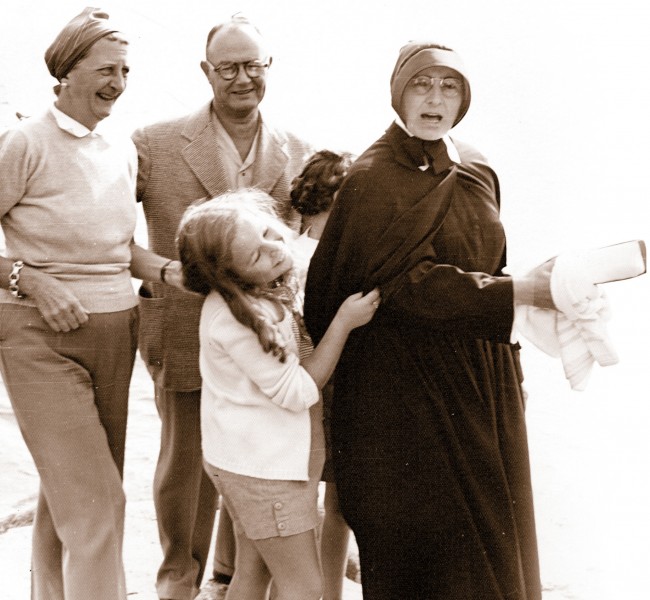 Sr. Florence Marie Scott graduated from Seton Hill in 1926, and 82 years later she is still serving as an inspiration to the students she taught after earning her Ph.D. and returning to Seton Hill as a biology professor. Sr. Florence Marie also served as a trustee of the Marine Biological Laboratory at Woods Hole, Massachusetts, where she spent 32 summers working and conducting research, an opportunity she shared with numerous Seton Hill students. “Sr. Florence Marie was an outstanding role model,” says Patty Acquaviva Gabow ’65, who served as CEO of Denver Health and Hospital Authority for 20 years. “I remember collecting samples with her... she would tie up her habit and get the job done. She taught me very early on that a woman could enter a field dominated by men and not change who she is.” Sr. Florence Marie is known for the prayer with which she began each class: “Lord help me understand the truth and fire me with the courage to use it for Your honor and glory.”
Sr. Florence Marie Scott graduated from Seton Hill in 1926, and 82 years later she is still serving as an inspiration to the students she taught after earning her Ph.D. and returning to Seton Hill as a biology professor. Sr. Florence Marie also served as a trustee of the Marine Biological Laboratory at Woods Hole, Massachusetts, where she spent 32 summers working and conducting research, an opportunity she shared with numerous Seton Hill students. “Sr. Florence Marie was an outstanding role model,” says Patty Acquaviva Gabow ’65, who served as CEO of Denver Health and Hospital Authority for 20 years. “I remember collecting samples with her... she would tie up her habit and get the job done. She taught me very early on that a woman could enter a field dominated by men and not change who she is.” Sr. Florence Marie is known for the prayer with which she began each class: “Lord help me understand the truth and fire me with the courage to use it for Your honor and glory.”
1927
Saint Mary’s School for Boys was discontinued in 1927. Saint Mary Hall became the home of Seton Hill College’s Home Economics Department, and its “Home Management House,” which offered students practical experience in running a home and taking care of a baby. Home Management students lived in the practice house for six weeks, assuming roles of house manager, meal manager, mother, and hostess. A live baby, from the Roselia Foundling Asylum and Maternity Hospital (also run by the Sisters), lived in the practice house with the students and faculty Sisters. Sister Rose Angela Cunningham, who would become the chair of the Home Economics Department in 1945, lived in the practice home for 40 years.
1928
Ten years after the creation of the college, the young women of Seton Hill understood – and rejoiced in – their dual role as students and co-founders. An editorial in the October 1928 issue of the Setonian titled “My School” contains these words: “We are new people, comparatively speaking, and this is a new school. We are not the passive recipients of a legacy of tradition but the makers of it... It is our school. It is making us now; we will eventually make it, even though we have not yet the pride of aristocrats looking back on things accomplished, but the ardor of pioneers seeing great things ahead.”
1929
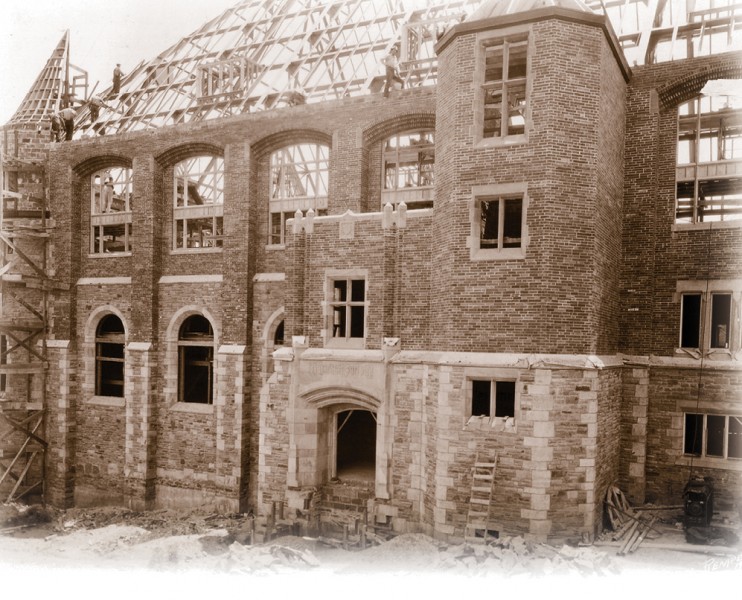
On October 25, 1929, an Alumnae Ball marked the official opening of Sullivan Hall. Called the Activities Building for almost twenty years - and still often referred to by visitors as “the castle building” - it was officially named in 1947 for the Rev. Daniel Richard Sullivan, fourth president of Seton Hill College. Designed in Norman Chateau style, Sullivan Hall contains a gymnasium and swimming pool. Through the years it has also housed a bowling alley, student lounges, student club offices, weight rooms, laundry rooms, athletics offices, cafes and the campus bookstore.
1930
Seton Hill establishes its Honors Program in 1930. Also in this year, The Alumnae Quarterly, the first official publication to keep graduates informed about the doings of their alma mater and their classmates, was published. President Sullivan explains the necessity for such a publication in a dramatic introduction to the inaugural June issue. He concludes his introduction with these memorable words: “ ‘Hazard yet Forward’ is Seton’s battle cry. Do not ask her to beat a retreat. She cannot. Like Napoleon’s drummer boy, her Masters never taught her that. Seton Hill goes forward. Setonites go forward. The advance of one is the advance of all. It should be known to all. The Alumnae Quarterly will make it known to all. Vivat! [live] Crescat! [grow] Floreat! [flourish]”
1931
Rev. James A. Wallace Reeves was inaugurated as the fifth president of Seton Hill in 1931.
1936
President Reeves, in honor of his interest in the cultural history of Italy, was knighted in 1936 with the Cross of the Chevalier of the Crown of Italy by the Royal Vice-Counsel of Italy. Also in 1936, Sr. Maurice McManama began her teaching career at Seton Hill. For more than 40 years she would have an extraordinary influence on the lives of those she taught. A professional psychologist, she also served as the chair of the Psychology Department for more than 30 years. President Eileen Farrell referred to Sr. Maurice as an “awe-inspiring teacher,” while Sr. Vivien Linkhauer described her as “a rare blend of scholar and practitioner in psychology, a combination seasoned by years of experience with students and clients.”
The High Road and the Low
1939
Priscilla Tully, of the class of 1939, described her Prom Night in May of that year in an article for the 1988 Seton Hill alumni magazine Forward. In it she recounts the popular theory among her peers that “the college’s authorities routinely laced our evening repast with saltpeter, a chemical thought to make us proof against any male blandishments...” She also describes “the high road and the low road,” the two separate paths the young women of Seton Hill and their dates were required to traverse after their original meeting in the Victorian parlors of the Administration Building. The young women, taking “the high road,” had to report to a Sister at the door, who recorded the minute each left the building. The students then crossed a little wooden bridge, known as the “Bridge of Sighs,” to get to the Activities Building, where the event took place. At the entrance to the Activities Building, another Sister checked each young lady in, and they were then reunited with their dates, who had been required to take the “low road” through a grassy field. Despite these obstacles, Priscilla remembers the evening as “sheer enchantment.” “Sometimes,” she says, “when the way it is gets in my way, I try to recall the way it was. I seek a serenity that may no longer exist. Or does it survive at Seton Hill?”
1941
President Reeves was asked to deliver the invocation at the opening of the Congress of the United States in 1941.
1944
To provide additional residence space for the College, the former Henry Coulter home on Mt. Thor Road was purchased and named in honor of Mother Regina Ennis on June 20, 1944. Ennis Hall accommodated 35 upperclassmen, a house mother, and three Sisters from the faculty. A large seminar classroom was located on the ground floor. Ennis Hall is currently being used exclusively by the Sisters of Charity.
1946
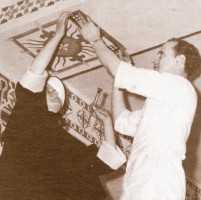 In 1946, 40 male World War II veterans were accepted as students at Seton Hill; these men were required to live off-campus. In his welcome to them, Dr. Daniel Carr, who served as their dean, said “We have lent you our college and we welcome you to it.” Student Mary Ruan Smith wrote in the June 1946 Setonian, “For the first time since 1941, the senior graduates can step from the commencement stage into a world of peace... No, war had not left Seton unaffected. It had not left the senior unaffected. She knew that the things of the past could never return; that Seton would always be changing to meet the demands of the present. And she left the stage proudly, a trifle serious because she knew that there was nothing to fear. She knew that the future was her.”
In 1946, 40 male World War II veterans were accepted as students at Seton Hill; these men were required to live off-campus. In his welcome to them, Dr. Daniel Carr, who served as their dean, said “We have lent you our college and we welcome you to it.” Student Mary Ruan Smith wrote in the June 1946 Setonian, “For the first time since 1941, the senior graduates can step from the commencement stage into a world of peace... No, war had not left Seton unaffected. It had not left the senior unaffected. She knew that the things of the past could never return; that Seton would always be changing to meet the demands of the present. And she left the stage proudly, a trifle serious because she knew that there was nothing to fear. She knew that the future was her.”
1947
Saint Joseph Academy was discontinued in 1947. In the same year, Saint Joseph Academy students presented Sr. Francesca Brownlee, an early directress of the Academy, with an award for “...her special interest in our individual welfare; for her words of wisdom: ‘Measure your deeds each day in the light of eternity,’ and... for being a wise counselor, inspiring leader, and an ideal Sister of Charity.”
1948
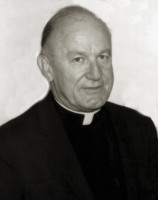 Msgr. William Granger Ryan was inaugurated as the sixth president of Seton Hill in 1948. (Mother Maria Benedict Monahan served as acting president of Seton Hill from 1947 until Msgr. Ryan’s inauguration.) President Ryan created the President’s Council, a group that included the college dean and treasurer, to advise him. This group transformed through the years into what is now the institution’s Board of Trustees, currently chaired by Seton Hill alumna and former Pennsylvania First Lady Michele Moore Ridge. Also in 1948, the first lights were installed along the College’s entrance drive.
Msgr. William Granger Ryan was inaugurated as the sixth president of Seton Hill in 1948. (Mother Maria Benedict Monahan served as acting president of Seton Hill from 1947 until Msgr. Ryan’s inauguration.) President Ryan created the President’s Council, a group that included the college dean and treasurer, to advise him. This group transformed through the years into what is now the institution’s Board of Trustees, currently chaired by Seton Hill alumna and former Pennsylvania First Lady Michele Moore Ridge. Also in 1948, the first lights were installed along the College’s entrance drive.
1951
In 1951, a nursery school was opened at Seton Hill under the direction of the chair of the Psychology Department, Sr. Maurice McManama, and the chair of the Home Economics Department, Sr. Rose Angela Cunningham. Also in 1951, Sr. Ann Infanger came to Seton Hill as a student. She became a Sister of Charity in 1956 and began her full-time teaching career at Seton Hill in 1963. A biology professor, Sr. Ann’s enthusiasm for all subjects, coupled with a calm, enduring faith, have made her an inspiration to generations of Seton Hill students. “I can’t look at a clear night sky without hearing Sr. Ann say: ‘Girls, do you know your constellations?,’ ” says Sr. Susan Yochum, a Seton Hill alumna and the current chair of the Division of Natural and Health Sciences. “I remember thinking: how great to be able to spend a life learning about different things!” said Sr. Ann during an April 2005 celebration of her years of service to Seton Hill. “And how wonderful to learn about God – because there would never be an end to the learning. God is always greater.”
1954
On May 30, 1954, Seton Hill, together with many members of the Greensburg community, celebrated the dedication of Saint Philomena’s Shrine at Seton Hill. The shrine contained a five-foot limestone statue of Saint Philomena. Her magnificent crown – of gold, diamonds and rubies – had been created using donated watches and jewelry. The shrine also contained a particle of bone from the body of the saint, sealed into a gold reliquary. The shrine and its attendant administration building were of unique design, using materials such as limestone, glass, stainless steel and marble in walls and floors. Sr. Marie Helene Mohr, Seton Hill’s reference librarian from 1954 – 1958, a devotee of Saint Philomena’s and the author of Saint Philomena, Powerful with God, had conceived of the shrine and been the force behind its construction. For years, the shrine attracted visitors, sometimes by the busload. In 1961, when Philomena was dropped from the Roman Catholic liturgical calendar of saints, the shrine closed. The statue disappeared – although a rumor claims that someone close to Philomena’s cause broke it into pieces and buried it, perhaps so the statue could never leave Seton Hill. The gold crown vanished. Since 1967, the shrine’s administration building has served as the offices for Project Forward Talent Search, a federally funded program that provides educational services, guidance, and financial aid information to disadvantaged youth interested in attending college.
1956
In 1956, Seton Hill issued its first honorary degrees, to the Right Rev. Mons. Paul J. Glenn; the school’s attorney, Robert W. Smith; and to a friend and benefactor of the college, Thomas Lynch.
1958
Dedicated on September 30, 1958, Reeves Library was named for Seton Hill’s fifth president. The library building also houses Reeves Theatre and Harlan Gallery. Havey Hall, a student residence named after the first president of the College, Mother Mary Joseph Havey, opened in the fall of 1958.
1964
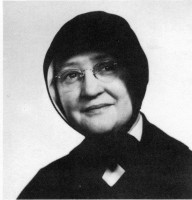 ''Educate a woman and you educate generations," was a favorite saying of Sr. M. De Chantal Leis, an advocate of educating women long before it was commonplace for women to receive a postsecondary education. Sr. De Chantal, who was known for her courage, integrity and dedication, earned a degree in classics from Seton Hill in 1923 and went on to receive a master's and Ph.D. from the University of Pittsburgh. Sr. DeChantal taught Latin at Seton Hill, and served as the department chair for 15 years. In 1939, she was appointed dean of women. Constance Angotti Salvitti '60 recounted the days when Sr. DeChantal kept a watchful eye over the women on campus. If they ventured into town without a hat or gloves, shopkeepers would call Sr. DeChantal to let her know. "She was at the front door of Admin until every girl checked in (after a night out)." On the evening of December 11, 1964, males were allowed to enter the residence halls for the first time. The fathers of students and other male family members were authorized to view–from 7 p.m. to 9 p.m. only - the Christmas decorations on the doorways of student rooms.
''Educate a woman and you educate generations," was a favorite saying of Sr. M. De Chantal Leis, an advocate of educating women long before it was commonplace for women to receive a postsecondary education. Sr. De Chantal, who was known for her courage, integrity and dedication, earned a degree in classics from Seton Hill in 1923 and went on to receive a master's and Ph.D. from the University of Pittsburgh. Sr. DeChantal taught Latin at Seton Hill, and served as the department chair for 15 years. In 1939, she was appointed dean of women. Constance Angotti Salvitti '60 recounted the days when Sr. DeChantal kept a watchful eye over the women on campus. If they ventured into town without a hat or gloves, shopkeepers would call Sr. DeChantal to let her know. "She was at the front door of Admin until every girl checked in (after a night out)." On the evening of December 11, 1964, males were allowed to enter the residence halls for the first time. The fathers of students and other male family members were authorized to view–from 7 p.m. to 9 p.m. only - the Christmas decorations on the doorways of student rooms.
1965
Brownlee Hall, named for Sr. Francesca Brownlee, the first academic dean of the College, was opened in the fall of 1965 as a student residence.
1969
In 1969, the administration of the Sisters of Charity moved from the college campus to Doran and Ennis Halls, near Mt. Thor Road on the hill above the school. This move helped to redefine the relationship between the Sisters of Charity and Seton Hill College. No longer interchangeable, the two entities were, and are, still firmly connected.
1970
Sr. Mary (Thecla) Schmidt was inaugurated as the seventh president of Seton Hill in 1970. Also in 1970, the Clay Frick Lynch Hall of Science, commonly referred to as Lynch Hall, was completed.
A Saint for Us
1975
 Elizabeth Ann Seton, founder of the Sisters of Charity, was canonized on September 14, 1975, making her the first American-born saint. A grand celebration was held on Seton Hill’s campus, complete with trumpeters on the rooftops. Sisters of Charity, and even a few students, had traveled to Rome prior to this date in support of her canonization; music professor Sr. Helen Muha sang in the choir at the canonization mass at Saint Peter’s Basilica in Rome. Sr. Mary Schmidt’s Saint Elizabeth Seton, The Holiness of an American Woman, first published in 1975, states of Saint Elizabeth Ann Seton: “She pioneered free education and stood for the rights of the poor and destitute, for racial equality and for religious freedom. Most importantly, she was a woman of consummate faith and hope and love. And she is ours to know; in her experience we can recognize our own...”
Elizabeth Ann Seton, founder of the Sisters of Charity, was canonized on September 14, 1975, making her the first American-born saint. A grand celebration was held on Seton Hill’s campus, complete with trumpeters on the rooftops. Sisters of Charity, and even a few students, had traveled to Rome prior to this date in support of her canonization; music professor Sr. Helen Muha sang in the choir at the canonization mass at Saint Peter’s Basilica in Rome. Sr. Mary Schmidt’s Saint Elizabeth Seton, The Holiness of an American Woman, first published in 1975, states of Saint Elizabeth Ann Seton: “She pioneered free education and stood for the rights of the poor and destitute, for racial equality and for religious freedom. Most importantly, she was a woman of consummate faith and hope and love. And she is ours to know; in her experience we can recognize our own...”
1976
Bayley Hall, the new home economics building located adjacent to Lowe Hall, opened in the fall of 1976. It was named in honor of Saint Elizabeth Ann Seton, whose maiden name was Bayley.
Intellect and Character
1977
Eileen Farrell was inaugurated as the eighth president of Seton Hill in 1977. Seton Hill’s first lay president, Ms. Farrell was a 1946 graduate of Seton Hill. “Seton Hill College since its inception has been concerned with the education of the whole person, the development of her intellect and her character,” she said in an interview with the Tribune-Review on November 14, 1977. “I intend to continue to move the College in this direction.”
1982
In the spring of 1982, the junior class planted a tree on campus that they dedicated to Sr. Muriel Flamman. Sr. Muriel had devoted 53 years to Seton Hill, as both faculty member and administrator. At the ceremony, Sr. Deborah Kelly said of Sr. Muriel: “Before she became academic dean, Sister was a professor of botany, and I’m sure she knows by name every flower, shrub and tree on this hill, and could probably even tell us when each was planted.” Also in 1982, the Sisters celebrated 100 years “on the Hill.” The celebration included a re-enactment of the first group of Sisters entering the then Stokes mansion; popular French professor Sr. Leah Wolf portrayed Mother Aloysia Lowe.
1983

In 1983, a scholarship for English majors was established at Seton Hill in memory of Sr. Miriam Joseph Murphy. It seems that no one who knew “Mimi Jo” – who taught in Seton Hill’s English Department for 43 years – is without a story about her, and her love for Shakespeare, poetry, Seton Hill English majors, and Ireland. One such story is told by Seton Hill President JoAnne Boyle, a former student and dear friend of Sr. Miriam Joseph: “Invited by Sam (Hazo) to sit in the front row when Gregory Peck came to read Yeats at the International Poetry Forum, she dazzled us afterwards on the ride home with her own hour-long recitation of the poems – as they should have sounded – had they been read with proper emphasis and subtleness of tone.”
1985
Seton Hill College began its Continuing Education program in 1985. This program was the forerunner of the current Adult Degree Program.
1986
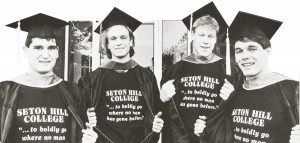 In 1986, the then School of Fine Arts began accepting male students interested in pursuing majors in art, theatre, communication, and music. While male students were also accepted into the Continuing Education program, the male undergraduate arts majors represented the first male college students to be housed on campus.
In 1986, the then School of Fine Arts began accepting male students interested in pursuing majors in art, theatre, communication, and music. While male students were also accepted into the Continuing Education program, the male undergraduate arts majors represented the first male college students to be housed on campus.
1987
JoAnne Boyle, Ph.D., a 1957 graduate of Seton Hill, was inaugurated as the College’s ninth president in 1987. Also in 1987, in response to the urging of Pope John Paul II to recognize the significance of the Holocaust and to “promote the necessary historical and religious studies on this event which concerns the whole of humanity today,” the National Catholic Center for Holocaust Education as established at Seton Hill.
1989
Sr. Margaret Burns, professor of math, computer science and general physics, initiated the school’s first Women in Science Day in 1989, to encourage, and acknowledge, talented local female high school students with an interest in the sciences.
1992
The National Education Center for Women in Business (re-named E- Magnify in 2006), was established at Seton Hill in 1992. In 2006, E- Magnify achieved designation as a Women’s Business Center (WBC) by the U.S. Small Business Administration.
1994
 The Windows to the Future Program, funded by the Richard King Mellon Foundation and the Mary Hillman Jennings Foundation in 1994, provided for the replacement of all 219 windows in the Administration Building – no two of which were the same size or shape. Commemorative plates were created using the original window glass and presented to alumni and friends of the Sisters and Seton Hill.
The Windows to the Future Program, funded by the Richard King Mellon Foundation and the Mary Hillman Jennings Foundation in 1994, provided for the replacement of all 219 windows in the Administration Building – no two of which were the same size or shape. Commemorative plates were created using the original window glass and presented to alumni and friends of the Sisters and Seton Hill.
1995
Seton Hill College offered its first two graduate programs, leading to a Master of Arts in Elementary Education, and a Master of Arts in Art Therapy, in 1995.
1998
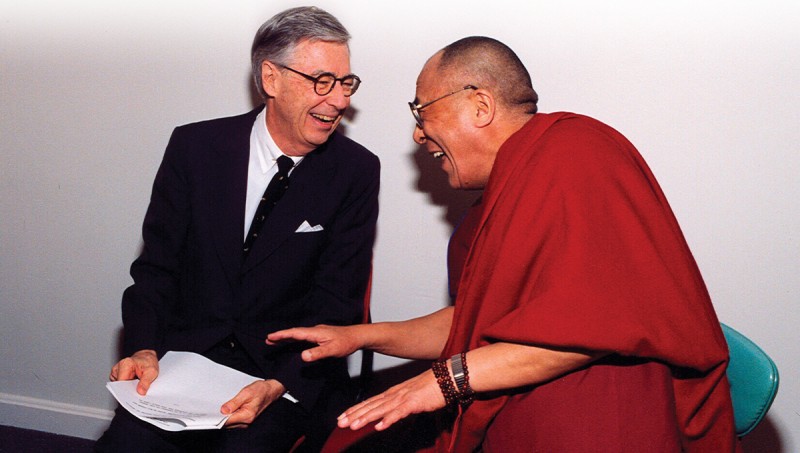
On November 11, 1998, Tenzin Gyatso, His Holiness the 14th Dalai Lama of Tibet, visited Seton Hill. The day’s events included two public lectures and a reception for faculty, staff and students. “It’s a beautiful day in this neighborhood,” said (Mister) Fred Rogers, who introduced the Dalai Lama at the first public lecture. In both talks, the Dalai Lama shared his belief that all faith structures lead their followers toward love, compassion, and forgiveness, and that religious faith is a source of personal strength. The Dalai Lama’s visit to Seton Hill was the fulfillment of a long-held dream for philosophy professor Chamu Namasivayam, who had worked for more than five years to make the dream a reality. Unfortunately, Namasivayam died just a few months prior to the Dalai Lama’s visit. She had once explained her educational philosophy in this way: “I want to teach students not just to think but to think with compassion and not be afraid to ask ‘why’.” In its efforts to “bring the world to Westmoreland County” Seton Hill has hosted numerous guest speakers on its campus, including former President of Poland Lech Walesa, commentator Lesley Stahl, Pulitzer Prize winning historian David McCullough, Pulitzer Prize winning humorist Dave Barry, and Pulitzer Prize winning author Frank McCourt.
2000
Seton Hill University’s Board of Trustees, in a meeting on March 10, 2000, formally adopted the Apostolic Constitution of the Supreme Pontiff John Paul II on Catholic Universities, “Ex Corde Ecclesiae,” which states, in part: “With every other University it shares that gaudium de veritate, so precious to Saint Augustine, which is that joy of searching for, discovering and communicating truth in every field of knowledge. A Catholic University’s privileged task is ‘to unite existentially by intellectual effort two orders of reality that too frequently tend to be placed in opposition as though they were antithetical: the search for truth, and the certainty of already knowing the fount of truth.”
2001
The 112-year-old Administration Building re-opened in 2001 after three years of extensive renovations. The newly refurbished building now accommodates growing enrollment, new programs, and technology-enhanced learning environments. The Administration Building’s reconditioning was undertaken in the best tradition of Mother Aloysia Lowe, with extreme care given to maintaining the building’s historic integrity. During the project, the beloved Victorian parlors were restored to their original grandeur, and eleven new classrooms and seminar rooms were constructed. As part of the grand opening festivities, the Saint Elizabeth Ann Seton Medal was presented to The Honorable Corinne (Lindy) Claiborne Boggs, the first female United States Ambassador to the Vatican.
This Way Up
2002
 In 2002, Seton Hill College was granted University status by the Pennsylvania Department of Education and became Seton Hill University, a name and status that represents the institution’s high caliber academic programs and rich heritage, while embracing its future as an institution offering a range of distinctive undergraduate and graduate programs. Also in 2002, Seton Hill officially became a coeducational institution, opening all academic programs to male students. “Seton Hill continues to grow to meet the challenges of new times in the best tradition of the Sisters of Charity who founded this institution,” said Sr. Gertrude Foley, then serving as president of the Sisters of Charity. Seton Hill introduced its first male sports, golf and soccer, and its new mascot, the Griffin, in the fall of 2002. The griffin is a legendary, medieval character with the head, beak and wings of an eagle and the body and tail of a lion. According to myth, griffins are blessed with the speed, flight and penetrating vision of the eagle, and the strength, courage and majesty of the lion, symbolically representing the combination of intelligence and strength. The Seton Hill community voted to make the Griffin the University’s mascot after a contest on campus had narrowed the choices down to three.
In 2002, Seton Hill College was granted University status by the Pennsylvania Department of Education and became Seton Hill University, a name and status that represents the institution’s high caliber academic programs and rich heritage, while embracing its future as an institution offering a range of distinctive undergraduate and graduate programs. Also in 2002, Seton Hill officially became a coeducational institution, opening all academic programs to male students. “Seton Hill continues to grow to meet the challenges of new times in the best tradition of the Sisters of Charity who founded this institution,” said Sr. Gertrude Foley, then serving as president of the Sisters of Charity. Seton Hill introduced its first male sports, golf and soccer, and its new mascot, the Griffin, in the fall of 2002. The griffin is a legendary, medieval character with the head, beak and wings of an eagle and the body and tail of a lion. According to myth, griffins are blessed with the speed, flight and penetrating vision of the eagle, and the strength, courage and majesty of the lion, symbolically representing the combination of intelligence and strength. The Seton Hill community voted to make the Griffin the University’s mascot after a contest on campus had narrowed the choices down to three.
2003
Dr. Gene “Doc” Saraceni, retired in 2003, joining his wife Iva, who had retired the previous year. The Saracenis had defined the Theatre Program at Seton Hill for 40 years. “Seton Hill’s late president, Msgr. William Granger Ryan, supported the establishment of a full theatre major at the university and put great trust in Iva and me. His faith in us allowed us to build the program,” Gene said at an event to honor the couple. “The students challenged us to grow and be better than we knew we could be, so they could have something to build on.”
2004
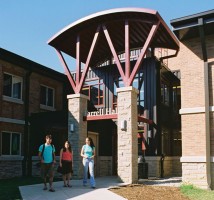 Farrell Hall, a residence hall named for former president Eileen Farrell, opened in September 2004. Seton Hill moved “off the Hill” for the first time in 2004, with the opening of the Seton Hill University Center for Family Therapy in downtown Greensburg. The Center, which is staffed by licensed clinical faculty and graduate students of Seton Hill’s Marriage and Family Therapy graduate program, provides individual, couple and family counseling services for the community.
Farrell Hall, a residence hall named for former president Eileen Farrell, opened in September 2004. Seton Hill moved “off the Hill” for the first time in 2004, with the opening of the Seton Hill University Center for Family Therapy in downtown Greensburg. The Center, which is staffed by licensed clinical faculty and graduate students of Seton Hill’s Marriage and Family Therapy graduate program, provides individual, couple and family counseling services for the community.
2005
The Katherine Mabis McKenna Center, a recreation center for students, opened on April 19, 2005. Featuring the Salvitti Gymnasium, a 1200-seat competition size multi- use basketball/volleyball court, the Center also offers an indoor running track, aerobics and fitness facilities, weight and athletic training facilities, and athletic department offices. “This blessing signifies that everything we do here is for the honor and glory of God,” said Bishop Anthony Bosco in his blessing of the building. “It does not, however, guarantee winning teams.” The exterior walls of Sullivan Hall serve as interior walls for the McKenna Center, a symbol of continuity that honors, said President Boyle at the Grand Opening ceremony, “the vision of those who went before us as we build for the future.” Seton Hill’s football team began its inaugural season in the fall of 2005. In September 2005, Seton Hill dedicated DeChantal Hall, a new residence hall named for Sister De Chantal Leis (“Dish” to her students), a Seton Hill alumna, former dean of students and Seton Hill’s first director of alumnae relations. In a poem dedicated to Sr. De Chantal, Karen Kucinski Palochik ’67 wrote: “She recognized in our minds a restless, turbulent, unyielding quality, but in the noisy confusion of life, kept peace in her soul, and taught us to keep peace in ours.” January 2005 also marked the first time Seton Hill offered January term – or “J-Term” – courses. These courses, held during the first few weeks of January when the rest of the school is closed, are intensive courses, usually with a focus on study abroad. Seton Hill also began offering M-Term courses (in May) in 2005.
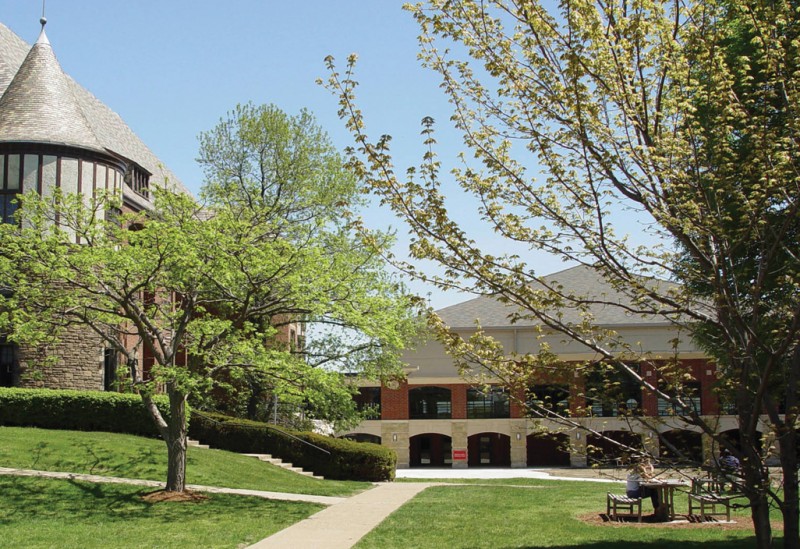
2006
On March 8, 2006, Seton Hill announced its move to Division II of the National Collegiate Athletic Association (NCAA) and the West Virginia Intercollegiate Athletic Conference (WVIAC).
2007
On July 2, 2007, Yad Vashem, Israel’s Holocaust Remembrance Authority, honored Sr. Gemma Del Duca, founder and co-director in Israel of Seton Hill’s National Catholic Center for Holocaust Education, with the Excellence in Holocaust Education award. Sr. Gemma was the first non-Israeli to be honored in this way. On August 28, 2007, at Seton Hill’s annual commemoration of Saint Elizabeth Ann Seton’s birthday, construction officially began for Seton Hill’s Performing Arts Center in downtown Greensburg. “Today we ask God’s blessing on this center of seeking, learning, teaching and performing what is true,” said Greensburg Bishop Lawrence E. Brandt, in his blessing of the construction site.
2008
In 2008 the U.S. Department of Education awarded Seton Hill a $1.9 million grant through its Title III Strengthening Institutions Program to equip classrooms in the latest in interactive and assistive technology, and to provide training for faculty in the best use of technology for teaching and learning. In December, Ethel LeFrak of New York, N.Y., donated $750,000 to the National Catholic Center for Holocaust Education to endow The Ethel LeFrak Holocaust Education Conference and create The Ethel LeFrak Student Scholars of the Holocaust Fund. Also in December, Seton Hill’s student-run literary magazine, Eye Contact, received a First Place with Special Merit award for its Spring 2008 “Revelation” issue from the American Scholastic Press Association (ASPA). In November, the football Griffins won their very first NCAA D-II playoff game, against the American International Yellow Jackets.
2009
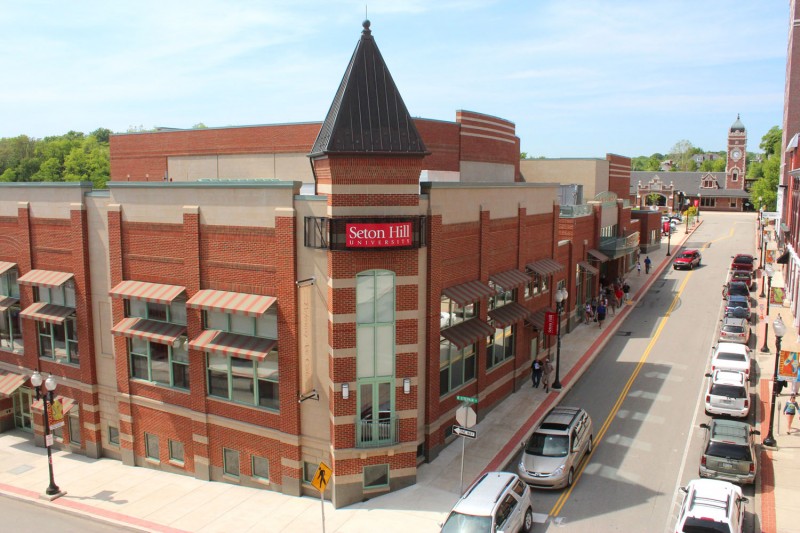
In February 2009, Seton Hill received a $3.5 million bequest from the estate of Carol Ann Reichgut, a 1956 graduate of the University. The bequest, the largest ever received by the university, created an endowed scholarship for minority students. As a tribute to Carol’s lifetime of teaching music to elementary school students, the University named the concert hall in the new Performing Arts Center in her honor. In September, the new Performing Arts Center celebrated its grand opening. The 73,000 square foot Center, located at the base of the Hill in Greensburg’s historic cultural district, features two mainstage performance spaces, the William Granger Ryan Theatre and the Carol Reichgut Concert Hall. The Center's classrooms, rehearsal studios and technical areas include the best equipment for learning and performing. The Lake Erie College of Osteopathic Medicine opened a new medical school on Seton Hill’s campus in 2009, and welcomed its first class of 109 future doctors in July. Also in 2009, trustee Daniel J. Wukich made a $2 million leadership commitment to enhance the University’s signature degree programs in business and the health sciences. In response, the University created the Wukich Center for Entrepreneurial Opportunities (Wukich CEO), which provides special services and programs to prepare students with the entrepreneurial skills needed to succeed in an evolving global market.
2010
Seton Hill University officially became an All-Steinway School in May 2010. (A significant financial commitment from former theatre professors Gene and Iva Saraceni, made in memory of their daughter, former Seton Hill student Elyse Jeanne Saraceni, had allowed Seton Hill to announce its intent to become an All-Steinway School in 2009.) In July, Seton Hill opened its new Center for Orthodontics, which trains dentists to become orthodontists while providing direct services to the local and regional community. Seton Hill became the first university in the world to commit to giving all full-time students and faculty the just-released iPad beginning with the 2010-2011 school year. (Seton Hill also committed to providing a MacBook to all incoming full-time freshmen.) Seton Hill’s pioneering stance on the use of this new mobile technology for teaching and learning prompted national recognition, including a featured spot in an educational video created by Apple. To enhance and expand the training and support the University provides to faculty on the use of technology in the classroom, Seton Hill opened the Center for Innovative Teaching.
2011
In April, Seton Hill hosted its first iTeach Gallery, showcasing faculty integration of technology into the curriculum. Examples included podcasts about pieces of art in the Westmoreland Museum and video documentaries of historic landmarks in Greensburg, both created by students studying to become teachers and tailored to a fourth grade audience; creating awareness of cultural contributions of Hispanics/Latinos by the creation of videos and interactive digital posters for musical acts participating in a Latino music festival; and a digital magazine that works like an app and serves as an interactive chemistry lab resource guide. Seton Hill continued to receive accolades for its mobile learning program; the university was named “eCampus of the Month” in October by eCampus News.
2012
In 2012, Seton Hill's Biology Program initiated research through the Howard Hughes Medical Institute Science Education Alliance's PHAGES (Phage Hunters Advancing Genomics and Evolutionary Science) project, while the Coordinated Program in Nutrition and Dietetics began a multi-year research collaboration with Walter Reed National Military Medical Center.
2013
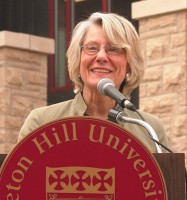 On January 17, long-term President JoAnne Boyle (pictured, right) announced her retirement. In July, Distinguished Alumna, honorary degree recipient and retired senior Ford executive Bibiana ("Bibie") Boerio was named interim president. "It's important to maintain the momentum and execute the university strategic plan and JoAnne's vision, " Bibie said. In November, Apple honored Seton Hill for the third time, naming the University an Apple Distinguished School through 2015. Seton Hill's Athletic Programs officially moved to the Pennsylvania State Athletic Conference. Seton Hill's ambitious $75 million campus expansion campaign resulted in two groundbreakings and the university's largest donation ($7 million from the R. K. Mellon Foundation) in 2013. The university broke ground on a new Dance and Visual Arts Center in downtown Greensburg in July, and the JoAnne Woodyard Boyle Health Sciences Center on main campus in October.
On January 17, long-term President JoAnne Boyle (pictured, right) announced her retirement. In July, Distinguished Alumna, honorary degree recipient and retired senior Ford executive Bibiana ("Bibie") Boerio was named interim president. "It's important to maintain the momentum and execute the university strategic plan and JoAnne's vision, " Bibie said. In November, Apple honored Seton Hill for the third time, naming the University an Apple Distinguished School through 2015. Seton Hill's Athletic Programs officially moved to the Pennsylvania State Athletic Conference. Seton Hill's ambitious $75 million campus expansion campaign resulted in two groundbreakings and the university's largest donation ($7 million from the R. K. Mellon Foundation) in 2013. The university broke ground on a new Dance and Visual Arts Center in downtown Greensburg in July, and the JoAnne Woodyard Boyle Health Sciences Center on main campus in October.
2014
On February 12, after a six-month search, Seton Hill announced its tenth president: Mary C. Finger, Ed.D. "Seton Hill has successfully met many challenges that the great majority of private colleges and universities in the United States are facing with creativity and a deep commitment to mission," said Mary Finger. "I am honored to be given the opportunity to serve as President of Seton Hill." Also in 2014, Forbes magazine named Assistant Professor of Chemistry Jonathan Moerdyk, Ph.D., one of the 30 scientists under the age of 30 “who are changing the world.”
2015
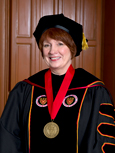 Seton Hill inaugurated President Mary C. Finger, Ed.D., as the 10th president of Seton Hill University on May 1, 2015. The ceremony concluded a weeklong campus celebration that featured a ceremonial tree planting, an event honoring the founders of the National Catholic Center for Holocaust Education, a student celebration presided over by a giant balloon Griffin, and a formal inauguration dinner and Mass. “Our students live in a world that is global, diverse, and interconnected - with all the beauty, opportunities, and challenges that that brings,” said President Finger in her inauguration speech. “It is our job, our commitment, indeed, our privilege to prepare them to navigate this complex environment.
Seton Hill inaugurated President Mary C. Finger, Ed.D., as the 10th president of Seton Hill University on May 1, 2015. The ceremony concluded a weeklong campus celebration that featured a ceremonial tree planting, an event honoring the founders of the National Catholic Center for Holocaust Education, a student celebration presided over by a giant balloon Griffin, and a formal inauguration dinner and Mass. “Our students live in a world that is global, diverse, and interconnected - with all the beauty, opportunities, and challenges that that brings,” said President Finger in her inauguration speech. “It is our job, our commitment, indeed, our privilege to prepare them to navigate this complex environment.
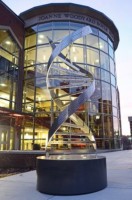 In the fall of 2015, the JoAnne Woodyard Boyle Health Science Center celebrated its grand opening. The 56,000 square foot facility features state-of-the-art technology and equipment, laboratories, and classrooms for Seton Hill’s natural and health sciences programs including physician assistant, nutrition and dietetics, exercise science, forensic science, chemistry, and biology. Nearly 40% of Seton Hill’s freshman class majors in a program of study in the sciences.”
In the fall of 2015, the JoAnne Woodyard Boyle Health Science Center celebrated its grand opening. The 56,000 square foot facility features state-of-the-art technology and equipment, laboratories, and classrooms for Seton Hill’s natural and health sciences programs including physician assistant, nutrition and dietetics, exercise science, forensic science, chemistry, and biology. Nearly 40% of Seton Hill’s freshman class majors in a program of study in the sciences.”
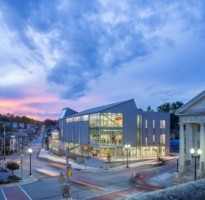 Also in 2015, the University opened the Seton Hill Arts Center. The Center houses dance and visual arts programs. The new building is a capstone to a decade-long partnership with the City of Greensburg to build and expand its cultural district in the downtown area.
Also in 2015, the University opened the Seton Hill Arts Center. The Center houses dance and visual arts programs. The new building is a capstone to a decade-long partnership with the City of Greensburg to build and expand its cultural district in the downtown area.
2016
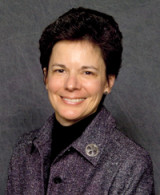 Under the leadership of new Provost Sister Susan Yochum, Seton Hill opened the Office of Academic Innovation and Planning to create new academic programs and partnerships that help students gain the skills needed to fill the region's workforce needs.
Under the leadership of new Provost Sister Susan Yochum, Seton Hill opened the Office of Academic Innovation and Planning to create new academic programs and partnerships that help students gain the skills needed to fill the region's workforce needs.
100 Years!
2018
 The year 2018 marks the 100th graduating class from Seton Hill University. Integral to Seton Hill's mission has been the decades of former students and alumni who have found their life's calling, led their communities, and transformed the lives of those they have served. The Centennial year will commemorate the achievements of Sisters, professors, administrators, alumni and students who came to cherish their experience "on the Hill."
The year 2018 marks the 100th graduating class from Seton Hill University. Integral to Seton Hill's mission has been the decades of former students and alumni who have found their life's calling, led their communities, and transformed the lives of those they have served. The Centennial year will commemorate the achievements of Sisters, professors, administrators, alumni and students who came to cherish their experience "on the Hill."
2019
 The U.S. Department of Education awarded Seton Hill a $2.16 grant in 2019 to prepare graduates for high-demand careers in STEM, and increase access and achievement of underprepared students in all programs of study. “The Title III Strengthening Institutions grant recognizes Seton Hill University’s historic strength in the sciences as well as its longstanding commitment to providing access to educational opportunities to traditionally underserved students,” said Seton Hill University President Mary C. Finger, Ed.D. Also in 2019, Seton Hill opened the Wukich School of Nursing and admitted students into its first Bachelor of Science in Nursing class.
The U.S. Department of Education awarded Seton Hill a $2.16 grant in 2019 to prepare graduates for high-demand careers in STEM, and increase access and achievement of underprepared students in all programs of study. “The Title III Strengthening Institutions grant recognizes Seton Hill University’s historic strength in the sciences as well as its longstanding commitment to providing access to educational opportunities to traditionally underserved students,” said Seton Hill University President Mary C. Finger, Ed.D. Also in 2019, Seton Hill opened the Wukich School of Nursing and admitted students into its first Bachelor of Science in Nursing class.
2020
Seton Hill University responded to the global COVID-19 pandemic by moving all classes online through the spring 2020 semester. On-campus classes resumed that fall. The members of the University community supported each other in true “Hazard yet Forward” fashion through the physical, emotional and academic challenges that continued throughout the next year.
2022
 Seton Hil received a variety of awards and recognitions in 2022. Apple named the University an Apple Distinguished School (for the 7th time!) The National Science Foundation awarded Seton Hill a prestigious grant intended to support biology, chemistry, biochemistry and forensic science majors from under-resourced environments. And students from diverse backgrounds studying accounting, finance and cybersecurity received additional support from a grant awarded through the KPMG U.S. Foundation. Seton Hill was one of only 5 institutions of higher education selected for this grant.
Seton Hil received a variety of awards and recognitions in 2022. Apple named the University an Apple Distinguished School (for the 7th time!) The National Science Foundation awarded Seton Hill a prestigious grant intended to support biology, chemistry, biochemistry and forensic science majors from under-resourced environments. And students from diverse backgrounds studying accounting, finance and cybersecurity received additional support from a grant awarded through the KPMG U.S. Foundation. Seton Hill was one of only 5 institutions of higher education selected for this grant.
2023
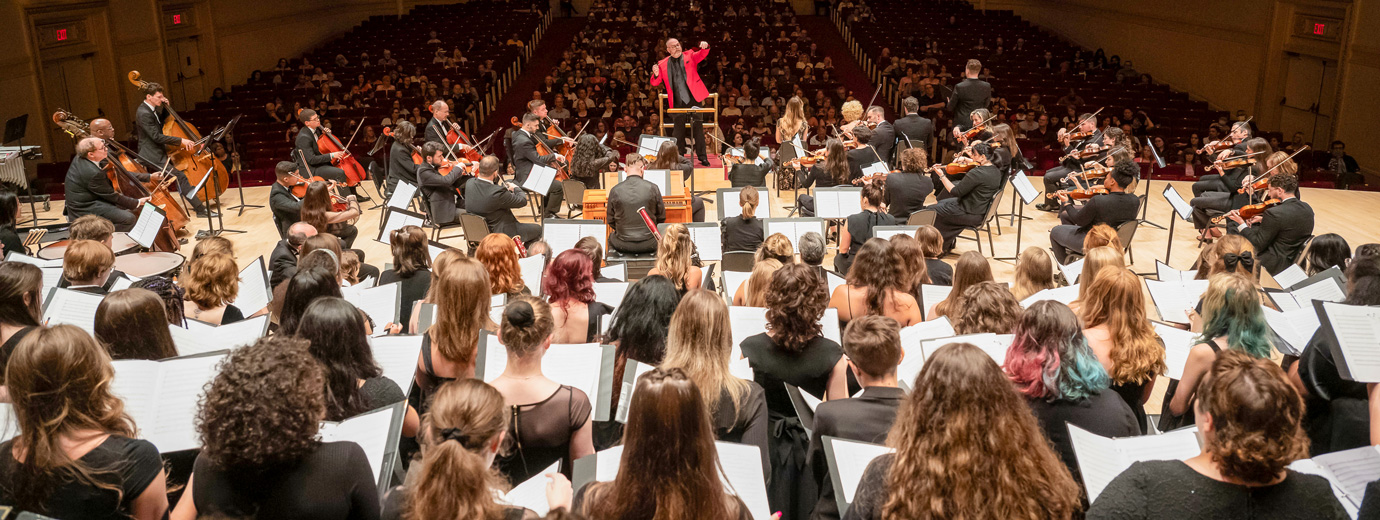 In 2023, Seton Hill faculty, students and alumni performed together in New York City’s Carnegie Hall. The women’s basketball team celebrated the 100th anniversary of hoops on the Hill. Off the Hill, the University joined with community partners to develop a plan for a healthcare-education corridor in the City of Greensburg.
In 2023, Seton Hill faculty, students and alumni performed together in New York City’s Carnegie Hall. The women’s basketball team celebrated the 100th anniversary of hoops on the Hill. Off the Hill, the University joined with community partners to develop a plan for a healthcare-education corridor in the City of Greensburg.
2024
Seton Hill’s Physical Therapy Doctoral program - which launched during the Pandemic Year of 2020 - made its first medical mission trip to Mexico and graduated its first class in 2024. Another new program, the Online Master of Arts in Applied Leadership in Criminal Justice, started classes in Fall 2024. Seton Hill’s baseball team celebrated its 700th win, and the University’s Model UN Team won awards while representing the Republic of Indonesia in the National Model United Nations Conference in New York City.Forward!
 Through the years, through the changes, Seton Hill has remained true to its mission - to educate students to think and act critically, creatively and ethically as productive members of society, committed to transforming the world. As Seton Hill exists for its students, its students and alumni are the most important part of its history, and of its future. Seton Hill is your home, as Mother Aloysia reminded each graduating student, adding: “come even if you don’t get an invitation.” And let all of us – alumni, students, faculty, staff, administration, family and friends – look to Seton Hill’s future, as did the students in 1928, with “the ardor of pioneers seeing great things ahead.”
Through the years, through the changes, Seton Hill has remained true to its mission - to educate students to think and act critically, creatively and ethically as productive members of society, committed to transforming the world. As Seton Hill exists for its students, its students and alumni are the most important part of its history, and of its future. Seton Hill is your home, as Mother Aloysia reminded each graduating student, adding: “come even if you don’t get an invitation.” And let all of us – alumni, students, faculty, staff, administration, family and friends – look to Seton Hill’s future, as did the students in 1928, with “the ardor of pioneers seeing great things ahead.”